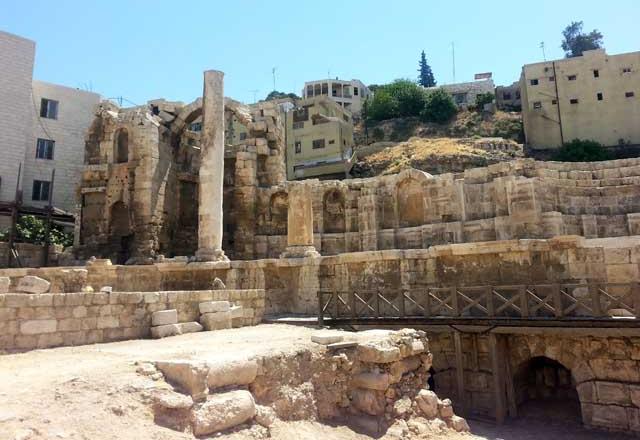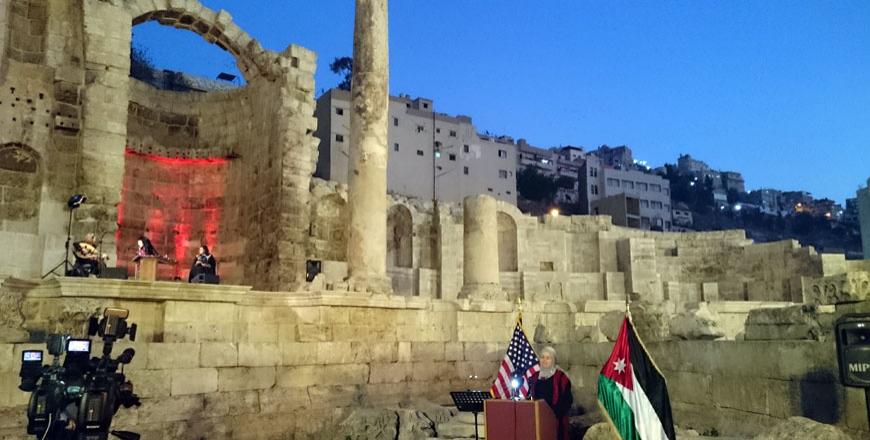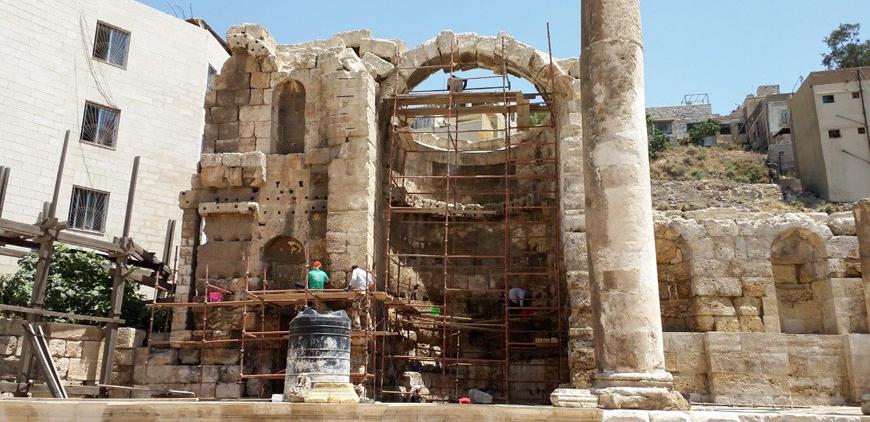You are here
US grant to fund restoration of Amman Nymphaeum
By Dana Al Emam - Aug 12,2014 - Last updated at Aug 12,2014

AMMAN — The Hamdi Mango Centre for Scientific Research (HMCSR) will benefit from a $200,000 US grant for the restoration and rehabilitation of the Roman Nymphaeum in downtown Amman.
Located between Souk Al Khudra and Prince Hashem Street, the Roman Nymphaeum is a large civic fountain with a towering structure from the ancient world where Romans used to bathe.
The Amman Nymphaeum, like many of the archaeological sites across the country, was damaged in the devastating earthquake that shook the region in 747AD.
The site quickly fell into disrepair, and up until the 1950s, houses were built right up next to the structure as modern Amman began to take shape.
Speaking at a ceremony to announce the grant on Tuesday, US Ambassador to Jordan Stuart E. Jones said the embassy will support the project to rehabilitate the Roman Nymphaeum, which he described as a “national treasure”, until completion.
“This is a modest grant, but we are really excited to be part of supporting this national historical complex in downtown Amman,” he told the audience.
Jones noted that the embassy is funding several projects across the city in progress at the same time, adding that he is “delighted” to spend his final days in Amman at the cultural heart of the capital.
The grant is from the Ambassador’s Fund for Cultural Preservation, established in the US Congress in 2001 to support the preservation of cultural sites, cultural objects and forms of traditional cultural expression around the world, according to an embassy statement.
Jordan has received nearly $1.3 million in grants to fund 12 unique cultural heritage preservation projects in places like Petra, Al Beida, Um Al Jimal, Abila, and the Jordan Valley since 2001, the statement added.
Amman Mayor Aqel Biltaji highlighted the historical and archaeological importance of the Roman Nymphaeum, stressing the Greater Amman Municipality’s (GAM) keenness to develop the site.
“We as GAM promise you that we will do everything we can to preserve and bring this place back,” he said at the ceremony.
“The Nymphaeum’s structure is considered one of the most important buildings still standing in the heart of the Decapolis city Philadelphia,” he added, voicing hope that the site will soon be open to the public as a tourist attraction.
According to the HMCSR, the Roman Nymphaeum in Amman was one of the principal buildings in the ancient city Philadelphia, now modern Amman.
The monument was built over a cave that provided running water to the city and is located at the intersection of two major historic avenues, the embassy statement said.
Department of Antiquities Director General Munther Jamhawi said the collaboration of several entities to restore the archaeological site provides technical and legal support for the national project.
The HMCSR is an independent unit at the University of Jordan (UJ) which was established by a grant from the late Ali Mango in 1999 to support interdisciplinary and research projects in the fields of applied science and technology.
UJ President Ekhleif Tarawneh said the university offers a programme in management and conservation of cultural resources, and has an archaeological laboratory where students receive training on maintaining antiquities.
“UJ has been involved in excavations across the Kingdom during the past 40 years,” he said, adding that the university is involved in preserving endangered archaeological sites in cooperation with the Tourism Ministry and several international bodies.
Related Articles
AMMAN — The second phase of the restoration and rehabilitation of the Roman Nymphaeum in Amman was launched on Tuesday.The project is implem
AMMAN — Around the corner of a busy downtown Amman street, as customers bargain with vendors over vegetable prices and passers-by flip throu
AMMAN — The newly rehabilitated Roman Nymphaeum Archaeological Park in downtown Amman was opened to the public on Monday after the completio














